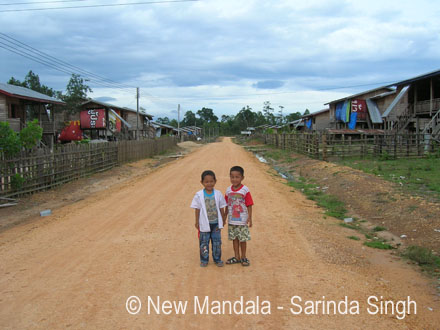Resettlement of villages on the Nakai Plateau for the Nam Theun 2 project has prompted much debate in Laos and more widely. Among other important issues, are questions about the “new” livelihoods the project envisaged for villagers and villagers’ perspectives on the changes they will experience. I was in Nakai very briefly this month and was able to re-visit people who I had stayed with three years ago, but this time in the resettled village where they moved in April this year.
Image 1: Recently resettled village on the Nakai Plateau
Image 2: Reservoir at the old village site.
In early 2005, just before the World Bank’s appraisal of the project, villagers expressed both strong desires for and concerns about Nam Theun 2 and the changes they were told it would bring (I have a forthcoming paper on this topic). Now as then, people’s views are mixed. As one young woman said of the new village, “some people like it, some people don’t.” Another explained that the new village “doesn’t have nature [thammasaat] like the old village but it is convenient”, noting especially the water tanks for each house during the wet season and wells for the dry season. Most striking, however, is how a sense of uncertainty appears to have become much more pronounced since the project moved from a possibility to an actuality.
Across the village, material possessions and amenities have markedly increased and provide immediate visual signs of “prosperity” that were lacking in the old village. This is not only with the large wooden houses, toilets, water tanks, power lines, electricity (2 hours per day) and fibreglass boats (1 per 2 households) provided directly by the project but also with televisions, small generators, satellite dishes, motorbikes, mobile phones and other household goods villagers’ themselves have acquired.
But the apparent increase in economic wealth is also associated with increased insecurity, which features both between and within households. For instance, deposits into the village bank for the last month varied hugely between households (from 5,000 Kip to 6,000,000 Kip per household). Likewise, a young mother repeatedly noted her “worry” (ut cay) about her children’s future. She explained that there are good jobs in Nakai, but these require education, money and connections, all of which are scarce commodities in the village. As another middle-aged woman explained, “if you had money in the old village then living in the new village is good, but if you didn’t have money then it is difficult.”
A sense of insecurity is very evident when villagers talk about the changes to two important components of their livelihoods — agriculture and natural resources. Regarding agriculture, villagers are especially concerned by the limited land available for grazing livestock and planting rice. For instance, villagers take large livestock to various grazing spots outside the new village, including the site of the old village, but point to protruding ribs and say how such skinny animals can only get a low price.
Image 3: Livestock grazing at the old village site
Image 4: But even at grazing sites outside the new village, livestock are “too skinny”.
Perhaps most visibly to the brief visitor, the newly built but completely unused village market attests to the persistent “marketing problem” that has challenged plans for vegetable production as a viable income-generating activity for resettled villages on the plateau. Villagers say that the Nam Theun 2 project previously told them they would grow vegetables to sell but now tells them the soils are too poor and, in any case, villagers themselves see the village market as having limited value when “there are no buyers.”
The second aspect of local livelihoods that is in flux is the use of natural resources. Fish are currently abundant in the reservoir but their low price in the district market limits their utility for villagers as a source of income. In contrast, forest resources are of continuing or increasing value but in diminishing availability. Villagers describe how areas near the old village that were abundant in bamboo shoots, rattan shoots, mushrooms and other forest products have now been flooded while the limited forest areas near the new village were quickly denuded in a quest for cash income after the village moved.
Image 5: Rice gardens with denuded forest in the background.
Plans for Nam Theun 2 envisaged livelihoods moving away from subsistence use of forest resources as they became integrated with the cash economy. While the latter is being achieved, the former is not as income earning opportunities (eg. Village Forestry Association) are limited and only accessible to those with “connections”. Thus, villagers have returned to collecting damar resin (kisii), which was banned in the lead-up to the official commencement of Nam Theun 2, travelling across the reservoir to the Nakai-Nam Theun National Protected Area (NPA) where it is more abundant. The construction of a small Berberine vine (khua haem) factory at the site of the old village site – funded by outside entrepreneurs and also next to the reservoir with easy boat access to the NPA – is another sign of the inter-twining of villagers’ livelihoods, natural resources and commerce.
Image 6: Berberine factory being built and reservoir in background.
Integration with the market economy provides new opportunities that appear to fit nicely with projects like Nam Theun 2 and national programs for development, but there are also significant challenges for making sure these mesh with the nominally congruent aims of poverty alleviation, social equity and sustainability. Despite the considerable effort put into planning for Nam Theun 2 (relative to other hydropower projects in Laos), gaps only become fully recognised at the time of implementation. What requires appreciation then, is that it is villagers who experience the effects of change, who are directly affected by oversights in preparation and who must live through the risks and uncertainties of resettlement.
Image 7: Villagers are the ones who must live through the uncertainties of resettlement.
 Facebook
Facebook  Twitter
Twitter  Soundcloud
Soundcloud  Youtube
Youtube  Rss
Rss 





